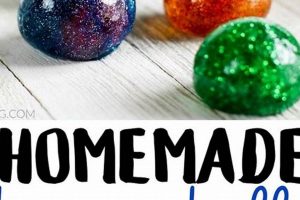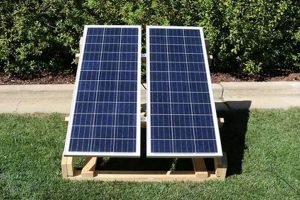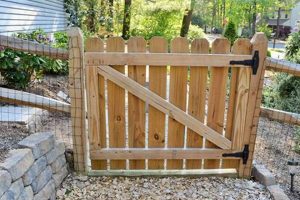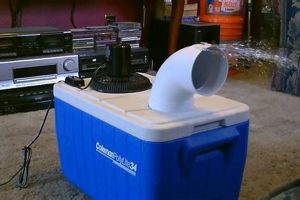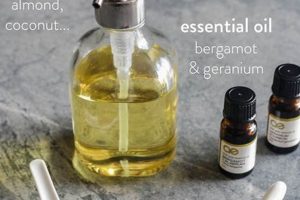The construction of a filtration system for aquariums frequently involves a secondary water reservoir to increase water volume and house essential equipment. A compact solution for smaller aquariums, particularly those around 10 gallons, involves utilizing fabricated enclosures made from transparent thermoplastic panels. These offer the advantage of customizability and the potential for cost-effectiveness in creating supplementary filtration systems for aquatic environments.
Implementing such a system enhances the stability of the aquarium’s ecosystem. The increased water volume dilutes waste products, leading to fewer fluctuations in water chemistry. Furthermore, it provides a dedicated area for equipment such as protein skimmers, heaters, and filter socks, keeping the main display tank uncluttered and aesthetically pleasing. Historically, similar methods have been employed to maintain water quality in aquaculture and advanced aquarium setups, reflecting a proven approach to water management.
The following sections will explore the design considerations, construction techniques, and material selection involved in creating such a supplementary filtration unit, alongside tips for ensuring proper functionality and long-term durability.
Construction and Implementation Tips
The following are essential guidelines for constructing and utilizing a supplementary filtration unit of the type described.
Tip 1: Material Selection. Opt for acrylic sheets with a minimum thickness of 1/4 inch to ensure structural integrity and prevent bowing under the weight of water. Higher grades of acrylic offer improved clarity and resistance to scratches.
Tip 2: Precision Cutting. Accurate cutting is paramount for a watertight seal. Employ a scoring knife and straight edge for controlled cuts. Consider professional laser cutting services for intricate designs and enhanced precision.
Tip 3: Solvent Welding. Use a dedicated acrylic solvent cement for bonding acrylic pieces. Apply the cement sparingly and evenly to create a strong, invisible bond. Ensure proper ventilation during the solvent welding process.
Tip 4: Baffle Placement. Strategically position baffles to control water flow and promote efficient filtration. Baffles can create distinct chambers for mechanical, biological, and chemical filtration, maximizing the system’s capabilities.
Tip 5: Leak Testing. Prior to integrating the system into the aquarium setup, conduct thorough leak testing with freshwater. Fill the enclosure completely and observe for any signs of leaks. Address any leaks immediately using additional solvent cement.
Tip 6: Sizing Considerations. Calculate the appropriate size based on the display tank’s dimensions and bioload. A sump volume equivalent to 20-30% of the display tank’s volume is generally recommended to provide sufficient water volume and filtration capacity.
Tip 7: Safety Measures. Utilize a drip tray beneath the filtration unit to contain any potential spills. Implement an overflow protection system in the display tank to prevent flooding in case of pump failure or power outage.
Adhering to these guidelines maximizes the functionality, safety, and longevity of a supplementary filtration system, contributing to a healthier and more stable aquatic environment.
The subsequent sections will elaborate on troubleshooting common issues and maintenance procedures to further enhance the performance of the filtration unit.
1. Acrylic Thickness
Acrylic thickness is a foundational parameter in the construction of a supplementary filtration unit for small aquariums. For a “10 gallon diy sump acylic sheet,” the choice of acrylic thickness directly influences the structure’s ability to withstand the forces exerted by the contained water. Insufficient thickness leads to bowing, potential cracking, and eventual failure, resulting in water leakage and compromising the filtration system. Real-world examples demonstrate that sumps constructed with acrylic sheets less than 1/4 inch thick are prone to deformation and catastrophic failure within a relatively short timeframe, particularly when fully loaded with water and filtration media. The practical significance of understanding this relationship lies in ensuring the longevity and reliability of the system, safeguarding both the aquatic ecosystem and the surrounding environment.
Furthermore, the thickness affects the ease of fabrication and the integrity of the solvent-welded joints. Thicker acrylic allows for a greater bonding surface, resulting in stronger and more durable seams. Conversely, using excessively thick acrylic can increase the cost and make the material more challenging to cut and work with, potentially offsetting the benefits in a smaller system. The optimal thickness for a 10-gallon system represents a balance between structural integrity, ease of construction, and cost-effectiveness. Therefore, empirical evidence and established best practices advocate for a minimum acrylic thickness of 1/4 inch to mitigate risk and ensure structural soundness in such applications.
In summary, the selection of acrylic thickness is not arbitrary but a critical engineering decision with direct consequences on the performance and durability of a “10 gallon diy sump acylic sheet”. While variations may exist depending on design and specific application, adherence to established thickness recommendations, supported by practical experience and material science principles, is paramount for avoiding structural failures and ensuring the successful operation of the filtration system. Any deviation from these guidelines necessitates careful consideration and potential reinforcement measures to compensate for the reduced structural capacity.
2. Bonding Strength
Bonding strength is a crucial factor in the fabrication of any aquarium sump, especially for a “10 gallon diy sump acylic sheet” construction. The integrity of the entire system depends on the permanence and reliability of the joints between the acrylic panels.
- Solvent Welding Chemistry
The process relies on a chemical reaction where a solvent softens and fuses the acrylic surfaces at a molecular level, creating a continuous, homogeneous material across the joint. Incomplete fusion due to improper solvent application, insufficient contact time, or contaminated surfaces results in weak bonds, increasing the risk of leaks and structural failure. Real-world failures often trace back to poorly executed solvent welding techniques.
- Surface Preparation Techniques
Proper surface preparation is essential to achieve optimal bonding. This involves ensuring that the acrylic surfaces are clean, free from debris, and slightly roughened to increase the surface area for bonding. Degreasing agents are used to remove any oils or contaminants that may interfere w
ith the solvent’s ability to fuse the acrylic. Failure to properly prepare the surfaces can significantly reduce the bond strength. - Joint Design and Load Distribution
The design of the joints directly impacts the distribution of stress across the bonded area. Butt joints are generally weaker than lap joints, which provide a larger bonding surface and improved load distribution. Reinforcement methods, such as using acrylic strips to create fillet welds, can further enhance joint strength. Careful consideration of these design factors is essential to ensure the sump can withstand the hydrostatic pressure of the contained water.
- Curing Time and Environmental Factors
The curing process requires adequate time for the solvent to fully evaporate and the acrylic molecules to cross-link, achieving maximum bond strength. Environmental factors such as temperature and humidity influence the curing rate. Insufficient curing time leads to weak joints that are susceptible to cracking or separation under stress. Maintaining optimal curing conditions and adhering to recommended curing times are crucial for achieving a strong, durable bond.
In summary, achieving adequate bonding strength in a “10 gallon diy sump acylic sheet” system necessitates a thorough understanding of the underlying chemistry, meticulous surface preparation, strategic joint design, and precise control of curing conditions. Any compromise in these areas directly undermines the structural integrity of the sump, increasing the risk of failure and potentially jeopardizing the entire aquarium setup.
3. Baffle Design
In the context of a “10 gallon diy sump acylic sheet,” baffle design is critical to the effective operation of the filtration system. Baffles are internal partitions within the sump that direct water flow, creating distinct zones for different filtration processes. Improper baffle configuration can lead to inefficient filtration, dead spots with accumulated detritus, and reduced overall water quality. The dimensions and placement of these partitions directly influence water velocity, contact time with filter media, and the separation of particulate matter. A poorly designed system may bypass filter media, negating the intended benefits of the sump.
For example, a common baffle arrangement involves three chambers: one for mechanical filtration (e.g., filter socks), one for biological filtration (e.g., bio-balls or ceramic media), and one for the return pump. The height and spacing of the baffles determine the water level in each chamber and the flow rate through the filter media. Lowering the first baffle allows particulate matter to settle, improving water clarity. Raising the middle baffle ensures the biological media remains submerged. The final baffle, positioned near the return pump, helps prevent microbubbles from entering the display tank. Real-world case studies demonstrate that optimized baffle designs significantly improve water parameters, reduce algae growth, and promote a healthier environment for aquatic life.
The effective design of baffles within a “10 gallon diy sump acylic sheet” is not merely a matter of physical construction but rather an exercise in applied fluid dynamics. The proper configuration maximizes filtration efficiency, prevents detrimental water flow patterns, and contributes significantly to the overall health and stability of the aquarium ecosystem. Challenges include accommodating various filtration methods within a limited space and ensuring ease of maintenance. However, a well-designed baffle system is an essential component of a successful sump-based filtration strategy.
4. Water Volume
Water volume, in the context of a “10 gallon diy sump acylic sheet,” directly impacts the stability and overall effectiveness of the aquarium’s filtration system. The additional water held within the acrylic sheet structure increases the total system volume, diluting concentrations of waste products such as ammonia, nitrite, and nitrate. This dilution effect minimizes rapid fluctuations in water chemistry, buffering against sudden changes that can stress or harm aquatic life. For instance, a sudden ammonia spike in a closed 10-gallon system can be catastrophic, whereas the presence of a supplementary filtration unit made with “acylic sheet” containing even a few additional gallons of water significantly reduces the severity of such an event. This dilution capacity is a primary benefit derived from integrating such a unit.
Beyond dilution, the increased water volume also enhances thermal stability. Larger volumes of water resist temperature fluctuations more effectively than smaller volumes. This is particularly relevant in smaller aquariums, where external temperature changes can rapidly affect the water temperature, potentially stressing or even killing sensitive species. The “10 gallon diy sump acylic sheet,” therefore, acts as a thermal buffer, moderating temperature swings and creating a more stable environment. Furthermore, the increased volume provides greater flexibility in accommodating equipment, such as heaters and pumps, without significantly impacting the available space within the main display tank. Practical applications include maintaining stable water parameters in nano reef aquariums and breeding tanks for sensitive fish species.
In summary, the water volume provided by a “10 gallon diy sump acylic sheet” is a critical component contributing to the health and stability of the aquarium ecosystem. By diluting waste products, enhancing thermal stability, and providing greater flexibility for equipment placement, the additional water volume acts as a buffer against environmental fluctuations. While challenges exist in maximizing water volume within the constraints of a small acrylic sheet structure, the benefits derived from increased water volume underscore its importance in supplementary filtration system design. The careful calculation and management of the system’s total water volume is a crucial consideration for ensuring the long-term success of any small aquarium setup.
5. Equipment Placement
Equipment placement within a “10 gallon diy sump acylic sheet” configuration significantly impacts the performance and maintainability of the entire filtration system. The compact nature of a 10-gallon sump necessitates strategic arrangement of components, including protein skimmers, heaters, filter socks, and return pumps. Suboptimal placement can lead to reduced filtration efficiency, increased noise levels, limited accessibility for maintenance, and potential damage to equipment. For example, positioning a heater too close to an acrylic surface can result in localized overheating and potential deformation or cracking of the “acrylic sheet” material. Conversely, inadequate spacing around a protein skimmer can impede its ability to efficiently remove organic waste, leading to a decline in water quality. Thus, equipment placement is not merely a logistical consideration but a critical factor influencing the functionality and longevity of the system.
Further considerations involve flow dynamics and interference. The positioning of the return pump inlet and outlet must be carefully planned to optimize water circulation within the sump and the display tank.
Poor placement can create dead zones with stagnant water or generate excessive turbulence, hindering filtration and disrupting the biological balance. The proximity of various devices can also create interference, such as the introduction of microbubbles from the protein skimmer into the return line. Mitigating these issues requires careful planning of equipment location relative to baffles and other internal structures. Moreover, accessibility for routine maintenance, such as cleaning the protein skimmer or replacing filter socks, must be factored into the layout. An inaccessible component becomes a liability, increasing the likelihood of neglect and eventual system failure.
In summary, equipment placement within a “10 gallon diy sump acylic sheet” requires a holistic approach considering filtration efficiency, thermal management, flow dynamics, interference reduction, and maintainability. While the limited space presents design challenges, thoughtful arrangement of components is essential for maximizing the benefits of a supplementary filtration system. Prioritizing accessibility and understanding the operational characteristics of each piece of equipment are paramount for ensuring long-term system performance and minimizing the risk of operational issues. Failure to address equipment placement adequately can negate the advantages offered by a sump, leading to reduced water quality and increased maintenance burdens.
6. Leak Prevention
Leak prevention is paramount in the construction and operation of any aquatic system, particularly with a “10 gallon diy sump acylic sheet.” The structural integrity and reliability of the entire filtration apparatus hinges on the ability to contain water without seepage or catastrophic failure. This section outlines crucial facets of leak prevention, highlighting their significance in the context of a small acrylic sump.
- Joint Integrity & Solvent Welding
The method and execution of solvent welding are foundational to leak prevention. Consistent, complete fusion of acrylic panels, achieved through precise solvent application and proper clamping, creates a monolithic structure resistant to hydrostatic pressure. Inadequate solvent welding results in micro-channels that propagate into larger leaks over time. Real-world examples reveal that improperly welded joints often fail along stress lines, particularly at corners or near plumbing connections.
- Material Selection and Thickness
The choice of acrylic material and its thickness directly influences leak prevention capabilities. Higher grades of acrylic exhibit greater resistance to stress cracking and deformation under pressure. Insufficient thickness, particularly in larger panels, can lead to bowing and eventual joint failure. A “10 gallon diy sump acylic sheet” requires a minimum thickness of 1/4 inch to mitigate these risks; thinner materials compromise the sump’s ability to contain water safely.
- Plumbing Connections and Sealants
Plumbing connections represent potential points of failure in any aquatic system. Secure, watertight connections between the sump and external plumbing are essential for leak prevention. The use of appropriate sealants, such as Teflon tape or silicone-based compounds, ensures a reliable barrier against water seepage. Improperly tightened fittings or incompatible sealants often lead to slow, persistent leaks that can damage surrounding surfaces.
- Testing and Monitoring Procedures
Rigorous testing and ongoing monitoring are crucial for identifying and addressing potential leaks. Before integrating the sump into the aquarium system, thorough leak testing with freshwater is mandatory. Regular inspections of all joints and plumbing connections allow for early detection of developing leaks, enabling prompt corrective action. Implementing a drip tray beneath the “10 gallon diy sump acylic sheet” provides an additional layer of protection, containing any minor leaks and preventing water damage to surrounding areas.
These facets underscore that leak prevention in a “10 gallon diy sump acylic sheet” is not a singular task but rather a comprehensive approach encompassing material selection, fabrication techniques, plumbing practices, and ongoing vigilance. Attention to these details is essential for ensuring the long-term reliability and safety of the filtration system.
Frequently Asked Questions
The following questions address common concerns and misconceptions surrounding the construction and implementation of supplementary filtration systems using transparent thermoplastic panels in smaller aquarium setups.
Question 1: What acrylic thickness is recommended for a “10 gallon diy sump acylic sheet” to prevent bowing or cracking?
A minimum acrylic thickness of 1/4 inch is strongly advised to ensure structural integrity and resist deformation under the weight of water. Thinner materials are susceptible to bowing and cracking, potentially leading to leaks and system failure.
Question 2: How should solvent welding be performed to achieve a watertight seal in a “10 gallon diy sump acylic sheet”?
Solvent welding requires careful surface preparation, even application of acrylic solvent cement, and proper clamping to ensure complete fusion of the acrylic panels. Insufficient solvent or improper clamping can result in weak, leak-prone joints.
Question 3: What are the key considerations for baffle placement within a “10 gallon diy sump acylic sheet” to optimize filtration?
Baffles should be strategically positioned to direct water flow through different filtration media, such as mechanical filters, biological media, and chemical reactors. The height and spacing of baffles influence water velocity and contact time with the media.
Question 4: How does the water volume of a “10 gallon diy sump acylic sheet” contribute to the overall health of the aquarium?
Increased water volume dilutes waste products, stabilizes water chemistry, and enhances thermal stability. This buffering effect minimizes fluctuations in water parameters, creating a more stable and healthy environment for aquatic life.
Question 5: What are the potential pitfalls of improper equipment placement within a “10 gallon diy sump acylic sheet”?
Suboptimal placement of equipment, such as heaters or protein skimmers, can lead to localized overheating, reduced filtration efficiency, increased noise levels, and limited accessibility for maintenance.
Question 6: What measures should be taken to prevent leaks in a “10 gallon diy sump acylic sheet” construction?
Leak prevention involves meticulous solvent welding techniques, proper selection of acrylic material and thickness, secure plumbing connections with appropriate sealants, and rigorous leak testing before integrating the sump into the aquarium system.
Prioritizing these considerations enhances the functionality and reliability of supplementary filtration systems, leading to a healthier and more stable aquatic environment.
The subsequent section will delve into troubleshooting common issues and maintenance procedures to further optimize the performance of these systems.
Conclusion
This exploration of “10 gallon diy sump acylic sheet” construction has underscored the importance of meticulous design, fabrication, and implementation. Key areas such as acrylic thickness, bonding strength, baffle configuration, water volume optimization, strategic equipment placement, and leak prevention have
been identified as critical determinants of system performance and longevity. Each element necessitates careful consideration to ensure optimal functionality and maintain a stable aquatic environment.
The successful deployment of a supplementary filtration system hinges upon a thorough understanding of the principles outlined. Adherence to established best practices and continuous monitoring are essential for maximizing the benefits and mitigating potential risks. Further research and development in materials and construction techniques will continue to improve the efficiency and reliability of such systems, contributing to the advancement of sustainable aquarium practices.


